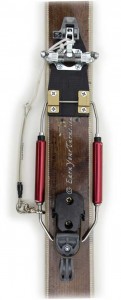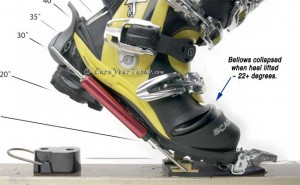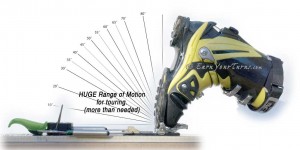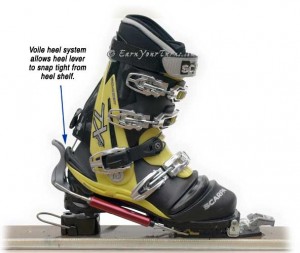
Dynafiddle Toe + Voile cable w/radical pivot location
+ Hammerheel. 2¼ lbs. per pair.
Click to enlarge.
Step 1: Squishing out some more room with toe caps via heat molding.
Step 2: Add some foam above my instep to help hold my heel in place, a necessary measure to balance the massive amount of resistance created by the super active pivot position of the TTS cable.
Step 3: The Targa heel throw had to go. The easiest solution was to substitute a Voile cable assembly for the G3. This was simple, and did the trick beautifully. Because of how aggressive the pivot location is pretension was set to minimal. It was enough to hold the heel lever tight and let me use the full range of Voile’s more linear spring compression.
Testing: Day 2
Next stop, Sugar Bowl ski resort, where the crowds aren’t too big, and you can use a lift or two to warm up before launching into the surrounding backcountry. The first two runs on groomers revealed the troubles with my inaugural run on the TTS binding were indeed the result of poor optimization. Driving the rear ski with lots of edge control was as good as I’ve ever experienced. I’ll have to do a side by side comparison with an NTN binding to confirm, but based on memory—at the worst—the TTS was on par with NTN, Axl, or Hammerhead for skiing power (see Verdict on TTS for that confirmation).
Out of bounds the inconsistencies of an unconsolidated snowpack were exacerbated by skiing with relatively small sticks and excess power under the bellows. When I hit grippy patches of wind buff broiled by the sun I would pitch forward causing the boot to compress to it’s limit but my knee was still at least six inches above the deck. It would not bend lower. I don’t know if that was the springs hitting their limit, or the boot refusing to bend at the cuff any further (the bellows had long since been fully compressed). Probably both.
Like its competitor, NTN, if you like to get low in your tele stance, the TTS will prevent you from achieving that. Those who tele more upright will love it. Lengel has mentioned plans to offer longer springs to allow a larger range of motion while turning.
Although I appreciated the extra control in variable conditions, I would have preferred a lower power setting, especially for a ski that was only 86mm at the waist. I have little doubt that I would embrace the level of power TTS delivered even more if I was driving a bigger rig and had more need of it. As it is, I’m very used to driving a ski in the mid-80mm range with Voile’s Switchback. That’s a dramatic shift, like going from HH 2½ to what feels like HH5+, maybe HH6+.
As ever, it is easier to adapt to harnessing more power than finessing your way with less. Even so, there are plans to offer a version with multiple cable pivot locations for fine tuning the power available.
So what is the bottom line here?
There is no question, Tech bindings (aka Dynafit) are not just the binding platform of choice for ski mountaineers with locked heels, but those with a tele-style free heel too. And just as trusting your legs to a Dynafit toe requires a certain measure of faith even with training heels, it is no less true with a permanently free heel either. The results are similar too.
It was a joy to skin up with Dynafit’s, but I must say, by comparison, I can still get into my Switchbacks faster and I don’t notice a lot of difference in uphill efficiency due to less weight or a potentially longer stride, because neither were evident in my particular mix of skis, boots and bindings. Over time I’m sure I’ll adapt my transition moves so it is as efficient as my current procedure.
I did manage to release out of the toes once on a climb because on this particular pair of bindings I couldn’t lock out the release due to some tolerance issues on the custom base plate. On this particular set up dimples from a prior binding mount pushed through the machined baseplate preventing me from pulling up on the lock out lever. Wasatch plans to make an injection molded baseplate for the production version to limit the effect of ski surface dimples from interfering with operation of the toe lockout.
The main reason I didn’t notice much difference in skinning efficiency between the TTS and a Switchback was mostly due to the boots. To date, most NTN boots are designed with the emphasis on downhill performance, most evident in universally tall cuffs regardless of manufacturer. But the real killer for touring efficiency with these boots, besides their weight, is the lack of backward movement of the cuff.
It would be nice if someone would make an NTN teleboot that had a cuff which could bend backwards like the Dalbello boots do, or Dynafits’ and Scarpa’s rando race boots, but also has two positions for skiing: 1) A fully forward lean position for aggro telemarkers and 2) a position that allows a large minority of us who like to ski in walk mode with a free floating cuff, but don’t want the cuff to move backwards past vertical.
I don’t know if this is a typical response with Dynafit bindings, but I did notice that the heel of my ski naturally dropped when doing a simple kick turn, so I didn’t have to snap the ski around at most switchbacks. When I did try a snap, I had to be careful not to snap too hard lest I kick the tip of the ski into my crotch.
Mark Lengel was savvy enough to outfit the TTS binding with a Hammerheel, my current favorite telemark climbing peg. The spring-loaded climbing peg snaps down, holding the heel lever in place when carrying your skis, or when skinning uphill in free-pivot mode. When you feel the need for climbing stilts, the climbing peg is easily flipped up just by tugging at it with a pole handle, or basket.
The question on many people’s minds, does TTS release?
Theoretically, yes.
Depending on what toe you chose for your TTS system, a release is possible, though I’ll speculate it is unlikely except in rare circumstances. The TTS comes with a choice of a Dynafit toe, with a release value comparable to DIN 13, or a Ski Trab Tech Toe with a DIN 11 rating. For most cases, this is strong enough to hold your boot without letting go prematurely, but might release in an egg beater fall. In my limited use of TTS so far, it didn’t release, nor should it have, so it passes my test for premature release. So far that is.
Availability
When will the TTS be available? Now, in limited quantities, as a beta binding. The price for dropping almost a pound per binding and increasing the touring range of motion to over 90°, and maintaining equal or greater downhill power is — compared to Rottefella’s NTN — a reduction in the ease of getting in and out of the binding, the loss of a ski brake (for the moment), and arguable releasability.
To obtain a pair you must part with $375 Federal Reserve notes for the Dynafit toe, or $475 for a Ski Trab TR RAce toe (approx. ¼ pound lighter with an easier, more elastic release). If you already have a Dynafit toe, talk to Mark about obtaining an adaptor kit. Contact him via email at info@wasatchski.com.
In any case, remember, this is a beta binding. Part of the deal is it is a work in progress, and you’re paying for the privilege of being on the test team. The benefit is you will have real input on the outcome and success of this binding, and be first in line for the “final” version.
I know there are a few others out there who have experience with this binding. Love to hear your comments below. Have questions? Fire away.
Related articles: Day 1 with TTS • Verdict on TTS • Faith required w/TTS
© 2011




7 comments
3 pings
Skip to comment form
Thanks Craig. Any thoughts on making the binding more streamlined, like using an under-the-foot cable routing system like the the O1, etc? That might neutralize the over activeness.
In your pictures it appears the toe assy. does not have a riser, but the heel does?
I never liked the clunkiness of hard wires versus flexy cables. I would like to see this Teletech binding expanded to allow a locked down heel option.
This is certainly way ahead of NTN. Hopefully by the 2013/14 season, when I need to replace my current set up, this will be market ready.
Author
Can’t comment on streamlining or routing the cable differently. That’s Wasatch Ski’s domain. It IS a beta binding, so you can bet there will be revisions and improvements.
The reality is, because of where the cable emminates from, it IS an underfoot cable routing. And the heel riser is a few millimeters higher than the toe, but not excessively so. I’d even say it is not noticeable while skiing or skinning.
As for over activeness, that is mostly a matter of what you’re used to. Did a side-by-side with Axl and have independent corroboration on how active it is, but you’ll have to wait for a future post for more details on that. I’ll just say my initial estimate wasn’t far off.
Craig, thank you for the thorough and detailed review, I found it well written with some good technical insight. I primarily ski the TTS system with F3 boots which work well for touring due to their flexible cuff and light weight, however when I go to a resort I use TX boots as they match the system well in terms of DH performance.
Everyone who demoed the system at OR using TX pros came away with the same observation you made about too much forward lean. Two of the skiers mentioned when they ski the boots in NTN bindings they will leave the boots in walk mode and also leave the top buckle loose (not undone) to compensate for the amount of forward lean the boots have.
You have identified two primary concerns I am working on to improve the TTS binding for our production version. To address the first issue, heel throw fit, we have a custom designed heel throw that matches the contour of the boot better when positioned on top of the sole. We also moved the heel bail up and inward to allow for greater pre-tensioning of the springs. On a side note I am able to get a modest amount of pretension when using the G3 heel throws (more when using one of the older, smaller Targa heel levers) which is enough to keep them engaged for the descent.
To address the 2nd concern, the range of motion with an engaged heel throw, I am exploring using longer spring cartridges that will allow a full “knee to ski” range of motion (this will manage shock loads better as well).
While I formerly preferred to do deep knee tele turns, the TTS binding has highlighted why a higher stance actually delivers more control of the skis. You’ve correctly noticed that the boot bellows fully compress long before the knee reaches the ski (or even gets close to what most would call a low tele stance), at which point one is able to continue to drive the knee forward only by lifting the ball of the foot off the ski. This is a range of motion limitation inherent to plastic boot design. I designed the TTS to automatically drive the ball of the foot to the ski immediately upon raising one’s heel, this helps to keep the skier properly balanced on the ski.
Thank you for the positive feedback and constructive suggestions, I look forward to seeing additional TTS reviews using other boots.
I’ve been following the TTS concept for a while now on various blogs/websites. As someone who has tele’d for 25 years on a huge range of gear – the possibility of actually seeing gear move ‘lighter’ and more capable rather than the endless progression to the market being dominated by lift-oriented boots/bindings… well the TTS idea is very interesting.
A couple of questions for any of the people who’ve been skiing it – and for the Wasatch Ski folks if they are checking in here.
1) A releaseable toe is a key for safe travel in avalanche terrain. The weight penalty for using a 7tm or NTN is pretty steep, so a light(er) releasable would be a huge improvement. What are the release characteristics of the toes you are using? Perhaps some benchtop testing has been done? Or qualitative results from skiing on them? How does the forward pressure from the heel affect the release (if there is any release at all). I would guess that with the Dynafit you need to lock it out. I’m curious as to what DIN standard you’d need to set one of the new La Sportiva toes to…
2) I’ve noticed that people are using F3s (and perhaps even F1s). With the boot breakage problems that NTN fought through in their initial year, I have to say that I’m a bit surprised that the F3/F1s, which aren’t optimized at all for tele, aren’t breaking as well… The idea of using some F1s and a TTS setup for a multi-week spring traverse is pretty damn appealing. But, obviously that needs to wait for a bit more development/test time! Gear breakage isn’t an option when you are 2 weeks out… I’ve been hoping for a F1 version of the NTN to be released. But the retail success of that system probably needs to improve before Scarpa/Rottefella come out with a light(er) version of the boot/binding that isn’t really designed for lifts and trips where weight isn’t a major factor.
3) Maybe I’m missing something, but isn’t the activity of this binding just a function of how far back the pivot point is mounted? It seems like having a couple of options – or simply a choice in mounting – would let people adjust things as they like.
4) Although the 7tm binding isn’t renowned for it’s performance (although the power model is better), the heel strap Doesn’t break (unlike cables for any manufacturer). It may be another option and could potentially be relatively easy to ‘trap’ under the foot plate. I think we all get tired of dealing with cable breakage… (although underfoot is obviously better).
I’d love to set one of these rigs up to test it.
I’m trying to track down some dynafiddle toes from friends…
Good luck with the R&D and testing!
Hammer_vn,
Thank you for your interest in the Telemark Tech System, I too had become tired of the current trend towards heavier gear. I switched to Dynafits a few seasons ago however I immediately missed the versatility and natural feel of telemark gear. It motivated me to develop numerous prior ideas I had around integrating a tech style toe to a telemark capable heel, ultimately resulting in the TTS binding after testing several different approaches.
I have done some limited torsion bar bench testing for the release. Using a size 27 TX boot it took approximately 130lbs. of torque to release using a Dynafit toe with G3 springs, around 110 lbs. of torque to release from a Ski Trab toe/G3 springs and around 120 lbs. using a Dynafit toe/Voile srpings. I ski the TTS the same way I skied Dynafits, with the toe locked for the ascent and unlocked for the descent. I have yet to pre-release from the TTS binding, for reference I’m 5’11” tall, a moderately aggressive skier and weigh 185-200lbs. without a pack (end of season/beginning of season weight). I have skied the TTS in all conditions, ranging from fresh powder to bumps to ice and corn. Only one time have I locked the toe for an exposed descent, a pre-cautionary measure many seasoned Dynafit users employ to prevent undesired release (ref Andrew McLean’s blog https://straightchuter.com/2011/01/wasatch-conditions-jan-30/). In my opinion the ability to lock the toe is one of the nice features of tech bindings.
When I switched to dynafits I specifically purchased F3 boots so I could start experimenting with some of the different TTS options I had in mind. I primarily ski the TTS using the F3s, so far no problems with the boots or bindings (I use the F3s for touring, in-bounds I ski the TX). Several friends who purchased TTS prototype bindings also ski them with F3 and F1 boots, none have had any issues to date.
To facilitate adjustable performance I have designed a mounting plate with alternative mounting positions (1 forward and 1 aft of the current mounting position), I’m also experimenting with block height and it’s impact on feel & fore-aft balance.
I am exploring using different heel connections, however I have not had a chance to integarate a 7TM style strap into the TTS binding. I do like having multiple options for springs that are compatible with the torsion rod we use for the rear heel connection (G3, Voile and Rottefella cartridges all work with the TTS system).
I am selling conversion kits without the tech toes, please send an email to mark@wasatchski.com if interested. Thank you for your input, I appeciate all the feedback provided!
Thanks,
Mark
Author
I should add that my original assessment of the power level of the TTS was a bit exaggerated owing to the fuzziness that occurs with memory over time and not doing a side by side comparison.
A week after I posted this report I was able to compare TTS with Axl. This isn’t a perfect side-by-side comparison since the boots, skis, and bindings were all different, but I think it still helped me recognize that TTS is not more powerful, but more on par with Axl #2 or #3 or Hammerhead #4 or #5.
Finally managed to rig my bigger, fatter test skis to do a true side-by-side comparison of the bindings that matter for this concept, NTN vs TTS. Same boot, same ski, different bindings. Look for that report around mid-March 2011.
Dynafit and Switchback light… a nice potential marriage especially if you can get the right resistance/pivot location in the pistons to get the ball of the foot closer to the ski. An interesting start for sure. might have to get a conversion kit and play with it.
[…] Posts: Verdict on Telemark Tech System Dynafit goes bi-sensual Day 2 on TTS Day 1 on […]
[…] the two months since my last report on the performance of the new TTS binding they’ve been put through a fairly thorough gauntlet […]
[…] look at why. Dostie took the perfect picture of the problem and commented on it briefly in his TTS review so we’ll look at that for […]